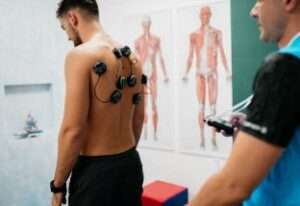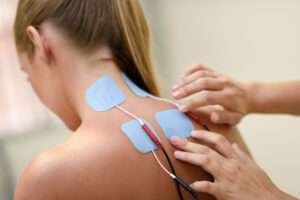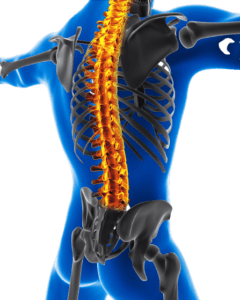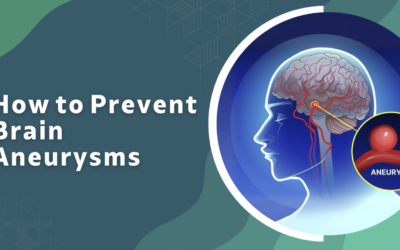Spinal Cord Stimulation in Mumbai
Spinal cord stimulation is a pain-relieving treatment that blocks pain signals from reaching the brain. A tiny device comparable to a pacemaker is implanted in the body to send electrical pulses to the spinal cord. This necessitates a great deal of precision and experience.
Dr Gurneet’s exceptional results in managing minimally invasive spine surgery and spine trauma have earned him a reputation as one of the most experienced spine surgeon in Mumbai.
Spinal cord stimulation aids in the management of chronic pain and the reduction of opioid medication use. If you have persistent back, leg, or arm pain and have tried everything else and still haven’t found relief, it might be worth a try. Dr. Gurneet Singh Sawhney, one of the best neurosurgeon in Mumbai, is renowned for providing safe and result-oriented spinal cord stimulation.
 What is a spinal cord stimulator and how does it work?
What is a spinal cord stimulator and how does it work?
A spinal cord stimulator (SCS) is a surgically implanted device that administers a moderate electric current to your spinal cord. Current is delivered to the nerve fibres of the spinal cord via thin cables from a pulse generator. When the SCS is on, it stimulates the nerves where you are experiencing pain. Pain decreases because the electrical pulses change and hide the pain signal before it reaches your brain.
Book An Appointment. Contact us now!
When is spinal cord stimulation used?
Spine surgeons often perform spinal cord stimulation when non-surgical pain treatments fail to provide relief. Spinal cord stimulators may treat or prevent a variety of chronic pain conditions, such as
- Back discomfort that persists despite surgery.
- Chronic pain following surgery.
- Arachnoiditis, painful swelling of the arachnoid, a thin membrane that shelters the brain and spinal cord.
- Angina, a heart pain that cannot be treated with other methods.
- Perineal pain and visceral abdominal discomfort.
- Injuries to the spinal cord.
- Nerve-related discomfort.
- Peripheral vascular disease (PVD).
- Complex regional pain syndrome (CRPS).
- Pain after amputation.
Who is a candidate for spinal cord stimulation?
If your pain management goals are appropriate for SCS, your surgeon will determine it by evaluating your physical state, medication regimen, and pain history. Patients eligible for SCS have suffered a chronic debilitating pain in their lower back, leg, or arm for at least three months. They have probably had one or more spinal procedures as well.
If you meet the following criteria, you may be eligible for SCS:
- Conservative treatments have not worked.
- Additional surgery would not be beneficial to you.
- The pain occurs from a fixable issue that should be addressed.
- You don’t want any further surgery because of the risks and the time it takes to heal.
- SCS may be a preference over extensive, sophisticated spine surgery in some cases.
- You don’t have an untreated drug addiction or depression, which should be addressed before an SCS.
- You have no medical issues that would prevent you from having the procedure done.
- You passed the SCS trial successfully.
There are two steps to determine whether spinal cord stimulation is a good option for you. You must first go through a trial period to discover if the device reduces your pain.
1st Stage: trial “test drive”: Trial stimulation is a “test run” to see if an SCS will work for your pain type, location, and severity. It is done in an outpatient setting. If you are using blood thinners, you will need to stop taking them 3 to 7 days before the trial. The surgeon uses a local anesthetic to numb the lower back area. Then, they introduce a hollow needle through the skin into the epidural space between the bone and the spinal cord using X-ray fluoroscopy. The trial lead is placed over specific nerves and implanted. Then, the surgeon will connect the wires to a belt-mounted external generator. The patient will return to the doctor’s office in 5 to 7 days to discuss whether the stimulator should be permanently implanted or the trial leads should be removed.
2nd Stage: placement of surgical implant: If the trial is effective and the patient experiences a more than 50% pain reduction, the surgeon can schedule surgery to implant the SCS device.
Schedule a consultation today and take the first step to a pain-free life!
What is the procedure for spinal cord stimulation?
The surgery usually lasts 1 to 2 hours.
- Step 1: Get the patient ready:
 The patient will be placed on the table on the stomach and given mild anesthesia. Then, the surgeon prepares the back and buttock areas for the placement of the lines and generator.
The patient will be placed on the table on the stomach and given mild anesthesia. Then, the surgeon prepares the back and buttock areas for the placement of the lines and generator. - Step 2: Implant the leads: With the use of fluoroscopy, the surgeon implants the electrode leads (a type of X-ray). Then, they expose the bone vertebra through a small skin incision in the centre of the back. The surgeon removes a piece of the bony arch (laminotomy) to make room for the leads. Then, the surgeon uses sutures to anchor the leads in the epidural area above the spinal cord. The leads do not come into direct contact with the spinal cord.
- Step 3: Perform a stimulation test: The patient may be awake to help the surgeon test how well the stimulation covers the pain locations, depending on the SCS device being implanted. On the other hand, modern SCS device leads can be placed based on anatomy or electric nerve monitoring. The trial settings will program the pulse generator after the procedure, so patient feedback ensures optimal pain relief. There may be no need to reposition or insert new leads if the leads implanted during the experiment are precisely positioned.
- Step 4: Tunnel the wire: The surgeon inserts wire through the skin from the spine to the buttock, where the generator will be implanted once the lead electrodes are in place.
- Step 5: Insert the pulse generator: Below the waistline, the surgeon creates a tiny skin incision and makes a space beneath the skin for the generator. Then, the surgeon connects the pulse generator to the lead wire. After that, the surgeon positions the generator correctly within the skin pocket.
- Step 6: Close the incisions: The surgeon uses sutures and skin glue to seal the incisions and places a dressing on the wound.
Why Choose Dr. Gurneet Sawhney for Spinal Cord Stimulation in Mumbai?
Dr Gurneet Singh Sawhney is a highly qualified and experienced neurosurgeon specializing in a wide range of spine surgeries.
Due to his constant ability to do result-oriented surgery for devastating spinal disorders, Dr. Sawhney is considered one of the best spine surgeon in Mumbai.
Moreover, he is also one of the few neurosurgeon in India with training in minimally invasive spine surgery.
Due to his sheer hard work, devotion, and tenacity, Dr. Gurneet Singh Sawhney has amassed over 14 years of experience.
The pleasant and inviting manner of Dr. Gurneet Sawhney makes him very approachable to his patients.
If you are looking for a specialist for spinal cord stimulation in Mumbai, contact Dr. Gurneet Sawhney to get the most effective treatment.
Frequently Asked Questions
What is the success rate of a spinal cord stimulation?
The long-term success rate of spinal cord stimulation (SCS) is currently between 47% to 74%. The time between the onset of chronic pain syndrome and the implantation of SCS is inversely related to its efficacy. Implantation should be done as soon as possible to improve outcomes.
How long does it take to recuperate from a spinal cord stimulation procedure?
After surgery, the patient should only engage in light exercise for at least two weeks. Most patients are entirely healed four weeks after surgery, but it might take up to twelve weeks.
Is it painful to have a spinal cord stimulation?
The early healing phase after spinal cord stimulation implantation can be uncomfortable like any surgery even minimally invasive.
How long does a spinal cord stimulator take to start working?
Instead, wires are placed, and electrical pulses are sent to electrical contacts near the spinal cord via an external transmitter. The doctors ask patients to record the level of pain alleviation in different scenarios throughout the day and night during the trial, which takes about five to seven days on average.
Blogs
How to Prevent Brain Aneurysms
Brain aneurysms are abnormal bulges in the brain’s blood vessels. If left untreated, these aneurysms can rupture, leading to severe health consequences such as stroke, brain damage, or even death. While preventing a brain aneurysm entirely is not always possible,...
Mini-Stroke Symptoms in the Elderly
A mini-stroke, also known as a Transient Ischemic Attack (TIA), occurs when there is a temporary blockage of blood flow to the brain. In elderly individuals, TIAs can be especially concerning, as they often signal an increased risk of a full-blown stroke. Dr. Gurneet...
What Are the 5 Warning Signs of a Mini-Stroke?
A mini stroke, medically called a transient ischemic attack, is the body's early alert that a major stroke may be developing soon. A brief blockage in the brain stops oxygen flow for minutes. Even though symptoms fade quickly, the impact on health is serious. These...

 What is a spinal cord stimulator and how does it work?
What is a spinal cord stimulator and how does it work?



